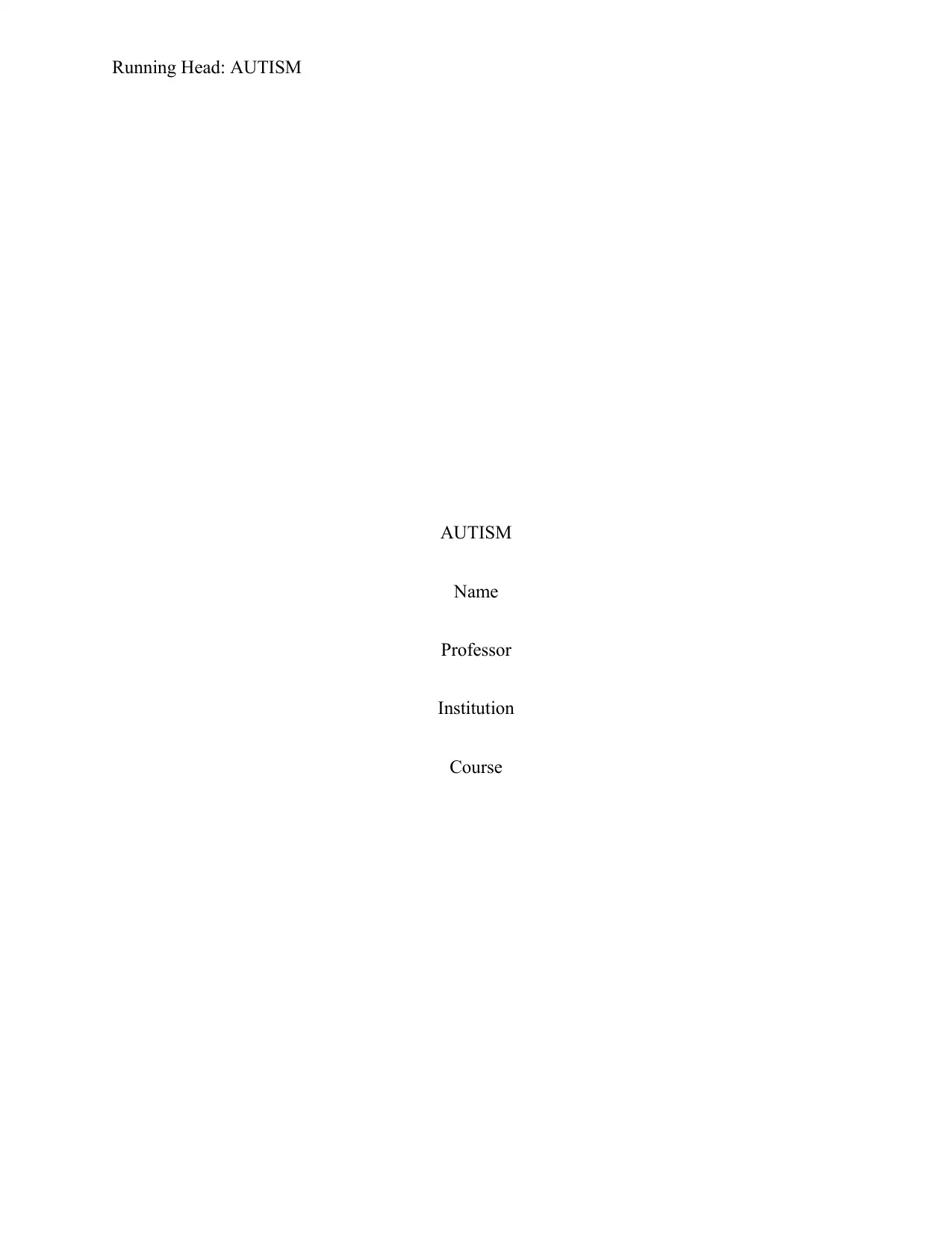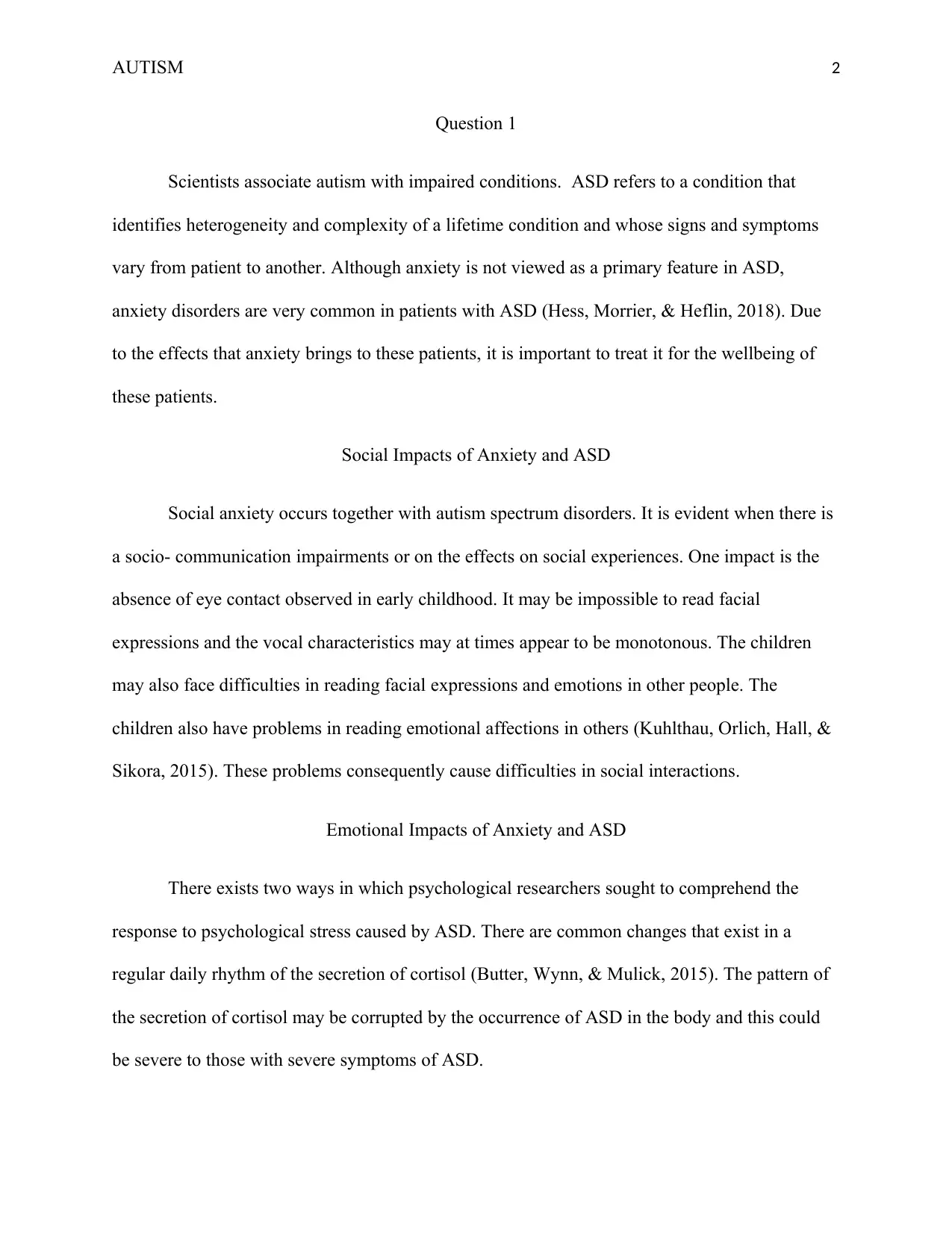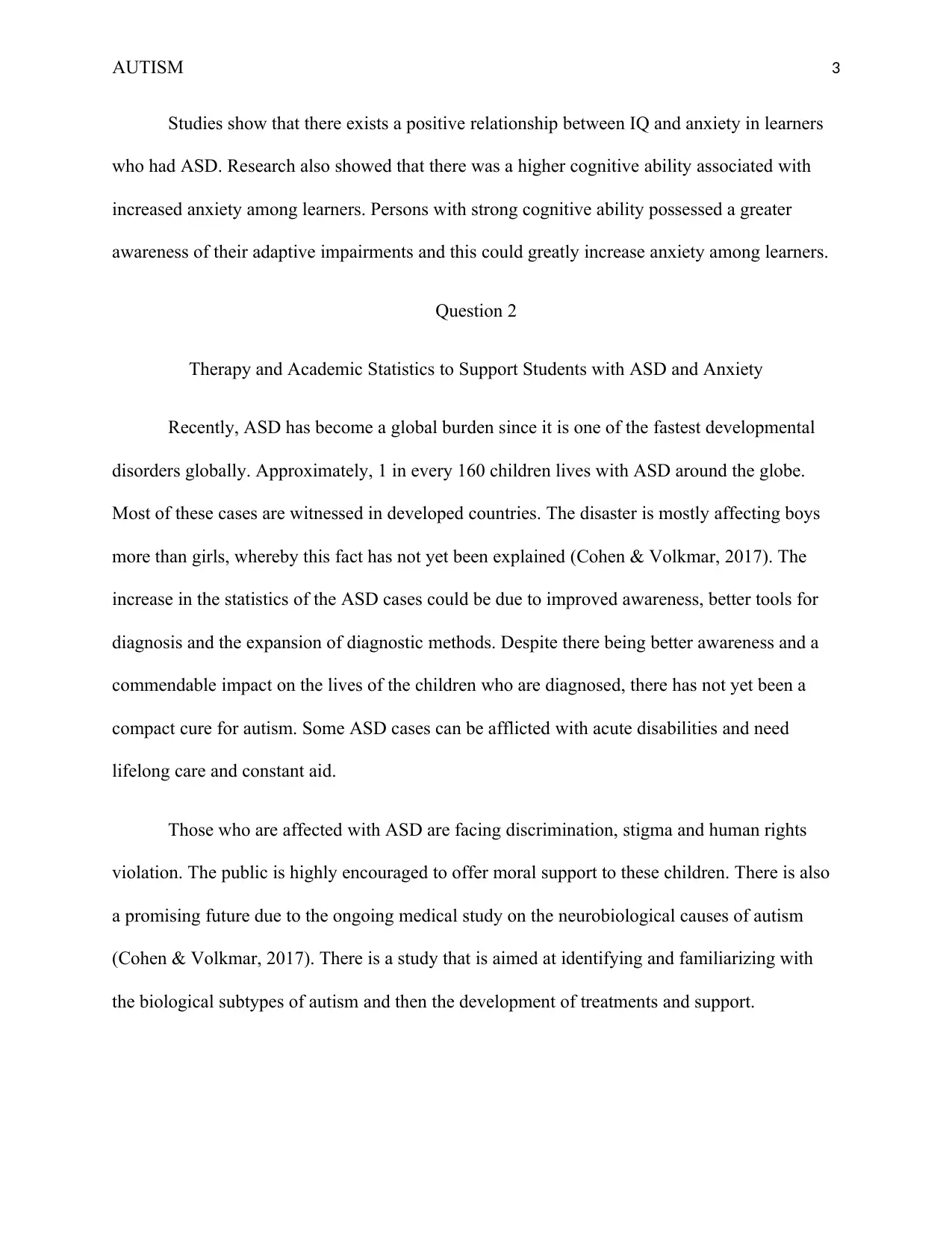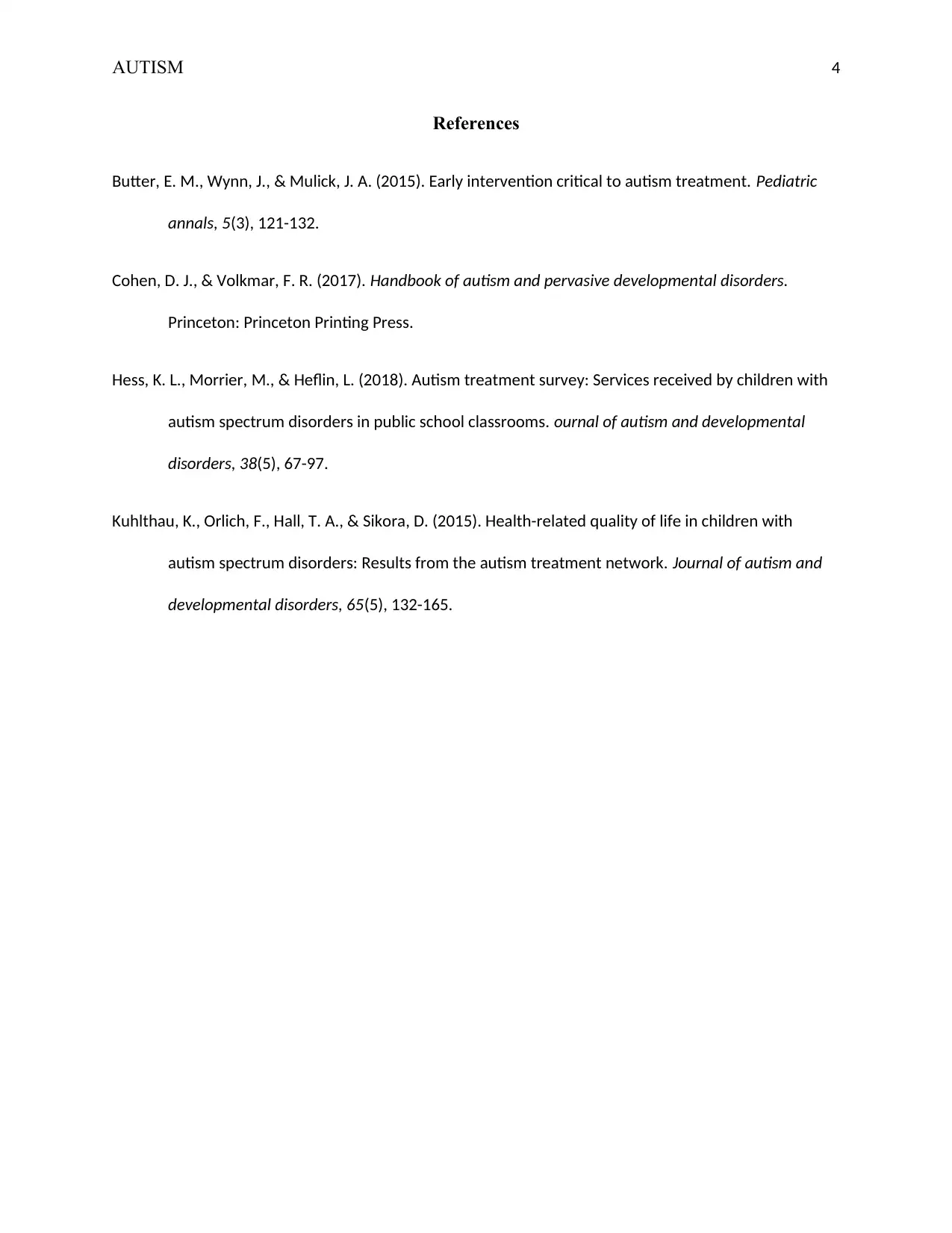Anxiety and Autism Spectrum Disorders: A Comprehensive Overview
VerifiedAdded on 2022/10/04
|4
|761
|489
Homework Assignment
AI Summary
This assignment examines the relationship between Autism Spectrum Disorder (ASD) and anxiety, addressing both the social and emotional impacts on individuals. It discusses the absence of eye contact, difficulties in reading facial expressions, and challenges in social interactions. The assignment also explores the emotional impacts, including changes in cortisol secretion patterns and the positive relationship between IQ and anxiety levels. Furthermore, the assignment provides recent statistics on ASD cases globally and emphasizes the importance of early intervention and public support. The document highlights ongoing medical research aimed at understanding the neurobiological causes of autism and developing effective treatments.

Running Head: AUTISM
AUTISM
Name
Professor
Institution
Course
AUTISM
Name
Professor
Institution
Course
Paraphrase This Document
Need a fresh take? Get an instant paraphrase of this document with our AI Paraphraser

AUTISM 2
Question 1
Scientists associate autism with impaired conditions. ASD refers to a condition that
identifies heterogeneity and complexity of a lifetime condition and whose signs and symptoms
vary from patient to another. Although anxiety is not viewed as a primary feature in ASD,
anxiety disorders are very common in patients with ASD (Hess, Morrier, & Heflin, 2018). Due
to the effects that anxiety brings to these patients, it is important to treat it for the wellbeing of
these patients.
Social Impacts of Anxiety and ASD
Social anxiety occurs together with autism spectrum disorders. It is evident when there is
a socio- communication impairments or on the effects on social experiences. One impact is the
absence of eye contact observed in early childhood. It may be impossible to read facial
expressions and the vocal characteristics may at times appear to be monotonous. The children
may also face difficulties in reading facial expressions and emotions in other people. The
children also have problems in reading emotional affections in others (Kuhlthau, Orlich, Hall, &
Sikora, 2015). These problems consequently cause difficulties in social interactions.
Emotional Impacts of Anxiety and ASD
There exists two ways in which psychological researchers sought to comprehend the
response to psychological stress caused by ASD. There are common changes that exist in a
regular daily rhythm of the secretion of cortisol (Butter, Wynn, & Mulick, 2015). The pattern of
the secretion of cortisol may be corrupted by the occurrence of ASD in the body and this could
be severe to those with severe symptoms of ASD.
Question 1
Scientists associate autism with impaired conditions. ASD refers to a condition that
identifies heterogeneity and complexity of a lifetime condition and whose signs and symptoms
vary from patient to another. Although anxiety is not viewed as a primary feature in ASD,
anxiety disorders are very common in patients with ASD (Hess, Morrier, & Heflin, 2018). Due
to the effects that anxiety brings to these patients, it is important to treat it for the wellbeing of
these patients.
Social Impacts of Anxiety and ASD
Social anxiety occurs together with autism spectrum disorders. It is evident when there is
a socio- communication impairments or on the effects on social experiences. One impact is the
absence of eye contact observed in early childhood. It may be impossible to read facial
expressions and the vocal characteristics may at times appear to be monotonous. The children
may also face difficulties in reading facial expressions and emotions in other people. The
children also have problems in reading emotional affections in others (Kuhlthau, Orlich, Hall, &
Sikora, 2015). These problems consequently cause difficulties in social interactions.
Emotional Impacts of Anxiety and ASD
There exists two ways in which psychological researchers sought to comprehend the
response to psychological stress caused by ASD. There are common changes that exist in a
regular daily rhythm of the secretion of cortisol (Butter, Wynn, & Mulick, 2015). The pattern of
the secretion of cortisol may be corrupted by the occurrence of ASD in the body and this could
be severe to those with severe symptoms of ASD.

AUTISM 3
Studies show that there exists a positive relationship between IQ and anxiety in learners
who had ASD. Research also showed that there was a higher cognitive ability associated with
increased anxiety among learners. Persons with strong cognitive ability possessed a greater
awareness of their adaptive impairments and this could greatly increase anxiety among learners.
Question 2
Therapy and Academic Statistics to Support Students with ASD and Anxiety
Recently, ASD has become a global burden since it is one of the fastest developmental
disorders globally. Approximately, 1 in every 160 children lives with ASD around the globe.
Most of these cases are witnessed in developed countries. The disaster is mostly affecting boys
more than girls, whereby this fact has not yet been explained (Cohen & Volkmar, 2017). The
increase in the statistics of the ASD cases could be due to improved awareness, better tools for
diagnosis and the expansion of diagnostic methods. Despite there being better awareness and a
commendable impact on the lives of the children who are diagnosed, there has not yet been a
compact cure for autism. Some ASD cases can be afflicted with acute disabilities and need
lifelong care and constant aid.
Those who are affected with ASD are facing discrimination, stigma and human rights
violation. The public is highly encouraged to offer moral support to these children. There is also
a promising future due to the ongoing medical study on the neurobiological causes of autism
(Cohen & Volkmar, 2017). There is a study that is aimed at identifying and familiarizing with
the biological subtypes of autism and then the development of treatments and support.
Studies show that there exists a positive relationship between IQ and anxiety in learners
who had ASD. Research also showed that there was a higher cognitive ability associated with
increased anxiety among learners. Persons with strong cognitive ability possessed a greater
awareness of their adaptive impairments and this could greatly increase anxiety among learners.
Question 2
Therapy and Academic Statistics to Support Students with ASD and Anxiety
Recently, ASD has become a global burden since it is one of the fastest developmental
disorders globally. Approximately, 1 in every 160 children lives with ASD around the globe.
Most of these cases are witnessed in developed countries. The disaster is mostly affecting boys
more than girls, whereby this fact has not yet been explained (Cohen & Volkmar, 2017). The
increase in the statistics of the ASD cases could be due to improved awareness, better tools for
diagnosis and the expansion of diagnostic methods. Despite there being better awareness and a
commendable impact on the lives of the children who are diagnosed, there has not yet been a
compact cure for autism. Some ASD cases can be afflicted with acute disabilities and need
lifelong care and constant aid.
Those who are affected with ASD are facing discrimination, stigma and human rights
violation. The public is highly encouraged to offer moral support to these children. There is also
a promising future due to the ongoing medical study on the neurobiological causes of autism
(Cohen & Volkmar, 2017). There is a study that is aimed at identifying and familiarizing with
the biological subtypes of autism and then the development of treatments and support.
⊘ This is a preview!⊘
Do you want full access?
Subscribe today to unlock all pages.

Trusted by 1+ million students worldwide

AUTISM 4
References
Butter, E. M., Wynn, J., & Mulick, J. A. (2015). Early intervention critical to autism treatment. Pediatric
annals, 5(3), 121-132.
Cohen, D. J., & Volkmar, F. R. (2017). Handbook of autism and pervasive developmental disorders.
Princeton: Princeton Printing Press.
Hess, K. L., Morrier, M., & Heflin, L. (2018). Autism treatment survey: Services received by children with
autism spectrum disorders in public school classrooms. ournal of autism and developmental
disorders, 38(5), 67-97.
Kuhlthau, K., Orlich, F., Hall, T. A., & Sikora, D. (2015). Health-related quality of life in children with
autism spectrum disorders: Results from the autism treatment network. Journal of autism and
developmental disorders, 65(5), 132-165.
References
Butter, E. M., Wynn, J., & Mulick, J. A. (2015). Early intervention critical to autism treatment. Pediatric
annals, 5(3), 121-132.
Cohen, D. J., & Volkmar, F. R. (2017). Handbook of autism and pervasive developmental disorders.
Princeton: Princeton Printing Press.
Hess, K. L., Morrier, M., & Heflin, L. (2018). Autism treatment survey: Services received by children with
autism spectrum disorders in public school classrooms. ournal of autism and developmental
disorders, 38(5), 67-97.
Kuhlthau, K., Orlich, F., Hall, T. A., & Sikora, D. (2015). Health-related quality of life in children with
autism spectrum disorders: Results from the autism treatment network. Journal of autism and
developmental disorders, 65(5), 132-165.
1 out of 4
Related Documents
Your All-in-One AI-Powered Toolkit for Academic Success.
+13062052269
info@desklib.com
Available 24*7 on WhatsApp / Email
![[object Object]](/_next/static/media/star-bottom.7253800d.svg)
Unlock your academic potential
Copyright © 2020–2025 A2Z Services. All Rights Reserved. Developed and managed by ZUCOL.




